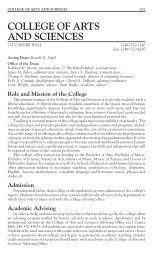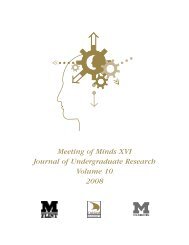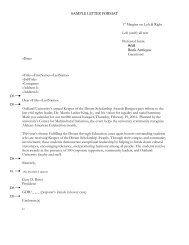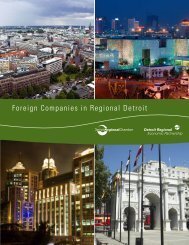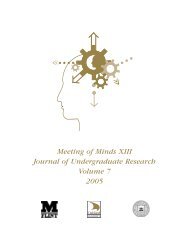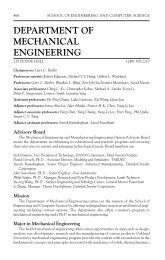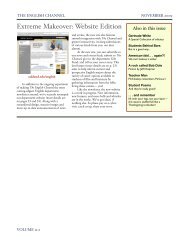MOM 2006 journal for pdf.pmd - University of Michigan-Flint
MOM 2006 journal for pdf.pmd - University of Michigan-Flint
MOM 2006 journal for pdf.pmd - University of Michigan-Flint
Create successful ePaper yourself
Turn your PDF publications into a flip-book with our unique Google optimized e-Paper software.
AN INTRODUCTION IN THREE PARTS:<br />
EXAMINING THE FIRST THREE POEMS IN ELIZABETH BISHOP’S<br />
QUESTIONS OF TRAVEL<br />
Megan Charley<br />
Faculty Sponsor: Gladys Cardiff<br />
Department <strong>of</strong> English, Oakland <strong>University</strong><br />
Elizabeth Bishop’s book <strong>of</strong> poetry, Questions <strong>of</strong> Travel is <strong>of</strong>ten noted <strong>for</strong> its careful<br />
sequencing. As Thomas Travisano claims, the poems <strong>for</strong>m “a narrative <strong>of</strong> an observer’s growing<br />
cultural insight and even identification with what she observed” (Elizabeth Bishop: Her Artistic<br />
Development 135). That is to say, the early poems in the sequence dramatize the most cursory,<br />
tentative, and broad assessments <strong>of</strong> the speaker’s surroundings; and the later poems are just the<br />
opposite: detailed, observant, insightful glimpses into the core <strong>of</strong> life in Brazil. The placement <strong>of</strong><br />
the first three poems, “Arrival at Santos,” “Brazil, January 1, 1502,” and “Questions <strong>of</strong> Travel,”<br />
has also gained attention, <strong>for</strong> the way they compliment each other. Indeed, most critics consider<br />
them a trilogy; Travisano describes them as “a three-poem series that asks (and answers) related<br />
questions <strong>of</strong> travel” (135). Yet, the trilogy’s subject matter is quite different from the other<br />
poems in the book.<br />
This difference in subject matter may be the greatest reason critics read them as a trilogy.<br />
Individually, the subject matter <strong>of</strong> these three poems is different, but they share something none<br />
<strong>of</strong> the following poems have: an emphasis on the speaker. The works that follow express<br />
“growing cultural insight” <strong>of</strong> the observed, striving to illuminate the place and the people<br />
residing there. But this initial trilogy is most concerned with dramatizing the observer’s<br />
experience <strong>of</strong> setting. The reader gains an understanding <strong>of</strong> how the poet views travel and all the<br />
moral dilemmas which arise when one writes about a new place. I propose these “related<br />
questions <strong>of</strong> travel” and their answers are placed at the beginning <strong>of</strong> the book so we can reserve<br />
those answers <strong>for</strong> the poems which follow.<br />
As such, it is my argument that this trilogy serves not as the first poems in a sequence <strong>of</strong><br />
“growing cultural insight,” but as an introduction to that sequence. This heuristic introduction<br />
establishes Bishop’s various views and theories on travel writing; they include what constitutes<br />
adequate knowledge <strong>of</strong> a subject, which subjects are most worth writing about, and the danger an<br />
author / traveler places on her subject.<br />
Interior Knowledge<br />
The first poem, “Arrival at Santos,” elicits the idea <strong>of</strong> the interior in its final sentence: “We<br />
leave Santos at once; / we are driving to the interior” (39-40). It is this line which leads critics<br />
such as Angus Cleghorn to claim: “Questions <strong>of</strong> Travel (1955) is a volume that begins with<br />
tentative entrance into Brazil, and moves intermittently and variously into the interior.” But<br />
what, to Bishop, constitutes the interior?<br />
Meeting <strong>of</strong> Minds <strong>2006</strong> 46



